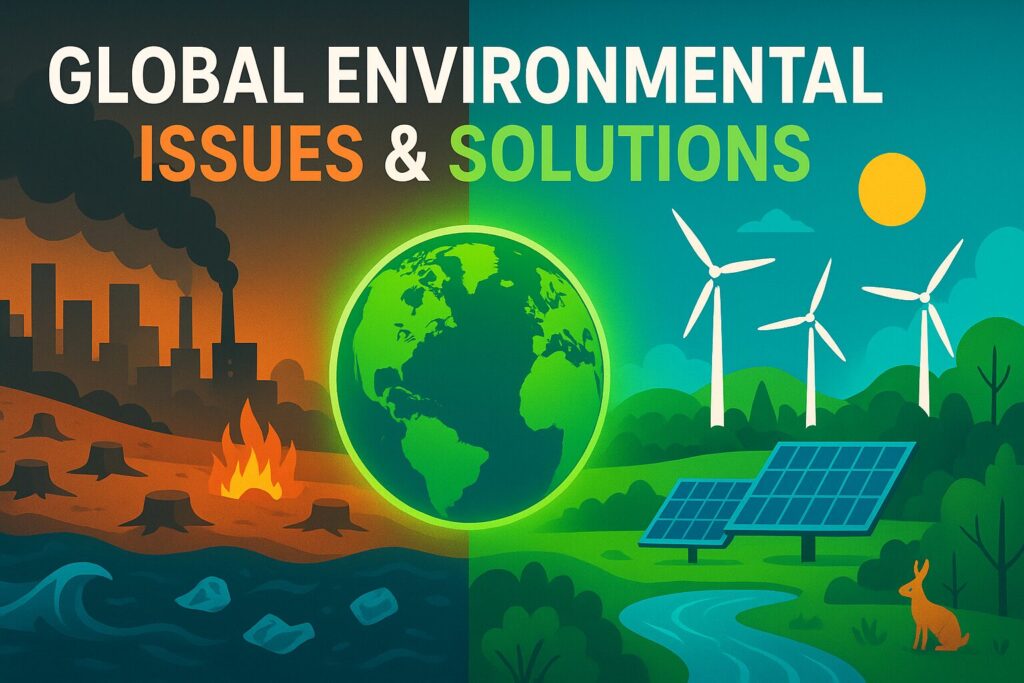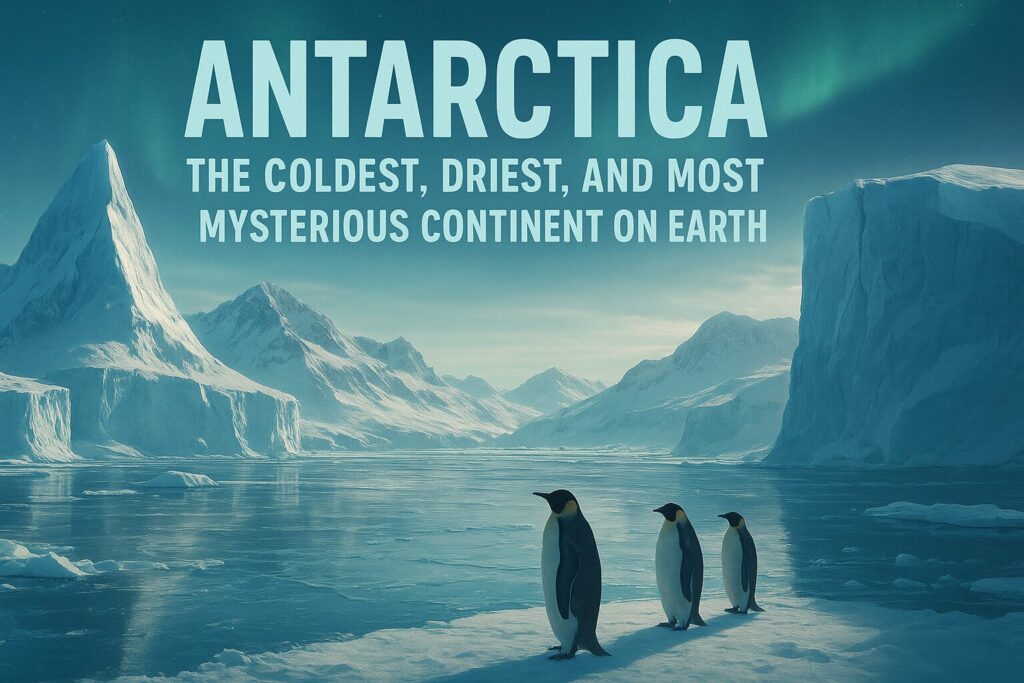Discover the environmental impact of the Great Pacific Garbage Patch, its effects on marine life, ecosystems, human health, and global efforts to clean it up.
Table of Contents
Introduction
The Great Pacific Garbage Patch is one of the most disturbing symbols of modern environmental neglect. Floating between Hawaii and California, this massive accumulation of plastic waste sprawls across an estimated 1.6 million square kilometers roughly twice the size of Texas. But it’s not a visible “island” of trash as many imagine. Instead, it’s a dense soup of microplastics and marine debris suspended just beneath the ocean’s surface.
Unlike natural phenomena, this patch is entirely human-made. It’s the result of decades of unchecked plastic use, poor waste management, and oceanic currents that funnel debris into a rotating vortex known as the North Pacific Gyre. And while its existence might feel far removed from daily life, its environmental impact is both far-reaching and deeply alarming.
In this article, we’ll dive deep into what makes the Great Pacific Garbage Patch so dangerous from the harm it causes marine life to its surprising ties to human health and global climate change. More importantly, we’ll explore the efforts being made to clean it up and what you can do to help.
What Is the Great Pacific Garbage Patch?
The Great Pacific Garbage Patch is not a single floating island of trash but a vast, dispersed accumulation of plastic debris caught in ocean currents. It exists in the North Pacific Ocean, between California and Hawaii, trapped in the North Pacific Subtropical Gyre a system of rotating currents that pulls floating materials into a slow-moving whirlpool.
What makes this area so deceptive is that most of the garbage doesn’t float visibly on the surface. Instead, it’s made up of microplastics tiny fragments of plastic less than 5mm in size mixed with larger debris like discarded fishing gear, plastic bottles, and packaging. This creates a cloudy, smog-like layer just below the surface that is incredibly difficult to detect and even harder to clean up.
Key Facts:
- Estimated size: About 1.6 million square kilometers (according to a 2018 study by The Ocean Cleanup).
- Weight: Approximately 80,000 metric tons of plastic.
- It contains over 1.8 trillion plastic pieces.
- It’s not visible from satellites, which is why the term “plastic island” can be misleading.
Ocean currents from across Asia, North America, and South America feed into this patch. Every year, millions of tons of plastic waste enter the oceans, and much of it ends up here, circulating for decades without breaking down completely.
The Great Pacific Garbage Patch isn’t the only one of its kind, but it is the largest and most studied, making it a powerful example of the global plastic pollution crisis.
What Materials Make Up the Garbage Patch?
The Great Pacific Garbage Patch is composed almost entirely of synthetic materials primarily plastics that do not biodegrade. Instead of breaking down into natural elements, plastic degrades slowly into smaller fragments through sunlight, wave action, and saltwater exposure. These fragments, known as microplastics, form the bulk of the patch.
The Main Components Include:
- Microplastics
These tiny particles make up the majority of the patch. They originate from broken-down items like bottles, bags, and packaging, as well as microbeads found in some personal care products. Their small size makes them particularly dangerous to marine life and impossible to recover efficiently. - Fishing Gear (Ghost Nets)
Surprisingly, discarded fishing gear nets, ropes, traps, and lines accounts for about 46% of the patch’s mass (based on data from The Ocean Cleanup). These “ghost nets” continue to entangle marine animals long after being abandoned. - Consumer Plastics
Items like:- Plastic bottles and caps
- Food wrappers
- Toothbrushes
- Flip-flops
- Styrofoam containers
are frequently found within the patch, mostly from land-based sources transported via rivers and storm drains.
- Hard Plastics and Fragments
These include broken bits of crates, buckets, and other durable goods. Sunlight weakens these materials, causing them to flake into microplastics over time. - Pellets (Nurdles)
These small, lentil-sized plastic pellets are used in plastic manufacturing. They’re often spilled during transport and easily swept into waterways. Once in the ocean, they absorb toxic chemicals and become even more harmful.
Why It Matters
Unlike organic waste, these materials can linger for hundreds of years. Their durability makes them ideal for human use, but catastrophic for marine ecosystems. Plus, plastics are petroleum-based, meaning they contribute to fossil fuel demand and emissions even before they reach the ocean.
The contents of the Great Pacific Garbage Patch reveal a haunting snapshot of consumer culture and industrial waste practices, highlighting the need for systemic change.
How It Affects Marine Life
The Great Pacific Garbage Patch is a deadly trap for marine life. From the tiniest plankton to the largest whales, creatures of the ocean are unintentionally swallowing, getting tangled in, or being poisoned by plastic debris. The consequences are both immediate and long-term and they’re devastating entire ecosystems.
1. Ingestion of Plastic
Many marine species mistake small pieces of plastic for food. Turtles think floating plastic bags are jellyfish. Seabirds scoop up bottle caps, cigarette lighters, and microplastics thinking they’re fish eggs.
- A 2015 study found that 90% of seabirds have plastic in their stomachs, and that number could rise to 99% by 2050 if trends continue.
- Ingested plastic can block digestive tracts, cause internal injuries, and trick animals into feeling full leading to starvation.
2. Entanglement in Debris
Abandoned fishing nets, also known as ghost nets, are a silent killer in the Garbage Patch. These invisible traps:
- Snare sea turtles, seals, dolphins, and fish.
- Prevent animals from surfacing for air, causing suffocation.
- Damage coral reefs and sea grass beds when dragged by currents.
A heartbreaking example occurred in 2018 when a dead whale washed ashore in the Philippines with 88 pounds of plastic in its stomach. These kinds of cases are increasingly common.
3. Toxic Contamination
Plastics in the ocean absorb toxic chemicals like PCBs and DDT from surrounding waters. When ingested by marine animals, these toxins enter their tissues and bioaccumulate up the food chain. Apex predators including humans then consume contaminated seafood.
4. Disruption of Habitat
Floating debris blocks sunlight from reaching plankton and algae near the surface critical sources of food and oxygen production. Even microscopic life is affected, which threatens the entire food web.
The impact of the Great Pacific Garbage Patch on marine life isn’t just about visuals of animals in distress it’s about the slow unraveling of biodiversity and balance in our oceans.
Impact on the Ocean Ecosystem
The Great Pacific Garbage Patch doesn’t just harm individual marine animals it disrupts the entire ocean ecosystem. The ocean is a delicately balanced system of organisms, nutrients, and energy flows, and introducing billions of plastic particles into that system has profound consequences.
1. Disruption of the Food Chain
At the foundation of the oceanic food web are plankton and small fish, which are now ingesting microplastics mistaken for food. These contaminated organisms are then eaten by larger predators, passing plastic and the toxins they carry up the food chain.
- A 2019 study found that zooplankton (tiny drifting animals) can ingest nanoplastics, affecting their reproduction and growth.
- When foundational species are compromised, the effects ripple throughout the ecosystem.
2. Chemical Pollution in Marine Systems
Plastics act like sponges in the ocean, soaking up persistent organic pollutants (POPs) like PCBs, BPA, and DDT. These chemicals leach into marine organisms and disrupt endocrine (hormone) systems, reproductive health, and genetic expression across multiple species.
- Coral reefs, already endangered by warming seas, are now facing additional threats from plastic-related pathogens. Research shows that corals that come into contact with plastic have an 89% chance of developing disease.
3. Invasive Species Rafts
Plastic debris provides new surfaces for invasive species to hitch a ride across oceans. Barnacles, crabs, mollusks, and even small plants can survive long voyages stuck to floating trash. Once they land in a new ecosystem, they can outcompete native species and throw the system into imbalance.
- This phenomenon was observed after the 2011 Japanese tsunami, when over 280 marine species traveled across the Pacific on tsunami debris and reached North American shores.
4. Loss of Biodiversity
With rising plastic concentration, the diversity of life in key areas of the Pacific is declining. Sensitive habitats like coral reefs, kelp forests, and breeding grounds are now being smothered or poisoned by persistent pollutants.
The Great Pacific Garbage Patch isn’t just polluting the ocean it’s changing the very way the ecosystem functions, weakening its resilience and productivity for future generations.
Human Health Risks
Although the Great Pacific Garbage Patch floats far from coastal cities, its impact isn’t confined to the ocean. The same plastic pollution that harms marine life is now entering the human food chain and the consequences for our health are growing more concerning by the year.
1. Microplastics in Seafood
Fish, shellfish, and even sea salt have been found to contain microplastics tiny fragments ingested by marine animals and accumulated in their tissues.
- A 2017 study by Ghent University in Belgium estimated that European seafood consumers ingest up to 11,000 plastic particles per year.
- These microplastics often carry toxic chemicals such as BPA, phthalates, and heavy metals that can leach into human tissues over time.
2. Toxic Chemical Exposure
Plastic absorbs environmental pollutants in the ocean. Once inside the human body, these endocrine-disrupting chemicals may interfere with hormone function, potentially contributing to:
- Reproductive disorders
- Developmental problems in children
- Increased risk of cancers
3. Contamination Through Water and Salt
It’s not just seafood. Plastics have been found in:
- Bottled and tap water (studies by Orb Media showed 93% of bottled water samples had plastic contamination)
- Commercial sea salt from oceans impacted by the Great Pacific Garbage Patch
- Even airborne microplastics that settle in food or are inhaled
4. Healthcare Concerns Still Emerging
The long-term effects of regular microplastic ingestion and exposure are not yet fully understood but early research points to chronic inflammation, gut microbiome imbalance, and oxidative stress, all of which are linked to chronic disease.
While research continues, one thing is clear: the Great Pacific Garbage Patch problem is no longer just an ocean issue it’s a growing human health concern with global implications.
Economic Consequences
Beyond its environmental and health toll, the Great Pacific Garbage Patch carries a significant economic cost impacting industries, communities, and governments around the world. From damaged fishing equipment to declining tourism revenue, plastic pollution is quietly draining billions from the global economy.
1. Damage to the Fishing Industry
The commercial fishing sector suffers some of the most direct financial losses due to marine debris.
- Ghost nets from the Garbage Patch entangle propellers, damage gear, and reduce fish stock.
- Lost or damaged fishing equipment is expensive to replace, and entangled nets can destroy entire hauls.
- According to the United Nations Environment Programme (UNEP), plastic pollution costs marine fisheries an estimated $1 billion annually.
2. Tourism and Coastal Cleanup
Beaches near ocean gyres including in Hawaii, California, and Pacific island nations often find their shorelines littered with waste carried by ocean currents.
- Tourists are less likely to visit polluted beaches, reducing local income from hotels, restaurants, and activities.
- Governments spend millions annually on beach cleanups, often with limited long-term success. For example, Japan spends over $100 million each year cleaning marine debris from its shores.
3. Shipping and Maritime Hazards
Large pieces of debris, especially ghost nets and plastic containers, pose navigational hazards to commercial ships.
- Collisions or entanglements with debris can damage vessels or delay trade routes.
- Insurance claims and maintenance costs increase as plastic-related damage becomes more common.
4. Long-Term Ecosystem Services Loss
Healthy oceans provide critical services carbon absorption, oxygen production, and food resources. The degradation caused by the Great Pacific Garbage Patch reduces these benefits, with economic value that is difficult to measure but deeply significant.
From local beach economies to international trade, the financial consequences of the Great Pacific Garbage Patch make a compelling argument for urgent action not just for nature’s sake, but for economic survival.
Climate and Environmental Connections
While the Great Pacific Garbage Patch is primarily seen as a plastic pollution issue, its links to climate change and broader environmental degradation are powerful and deeply intertwined. Plastics don’t just pollute the ocean; they also contribute to the climate crisis at every stage of their lifecycle.
1. Plastic Production Drives Fossil Fuel Emissions
Plastics are made from petroleum and natural gas, meaning they are essentially a form of fossil fuel. From extraction and refining to manufacturing and transportation, the plastic industry emits vast amounts of greenhouse gases (GHGs).
- According to the Center for International Environmental Law, plastic production is projected to emit over 1.34 gigatons of GHGs per year by 2030 equivalent to the emissions of more than 295 coal-fired power plants.
2. Decomposition and Methane Release
Even after plastics enter the ocean, their climate impact continues.
- Studies have shown that common plastics, when exposed to sunlight and seawater, release methane and ethylene, two potent greenhouse gases.
- This process can continue for decades, turning the Great Pacific Garbage Patch into a long-term emissions source.
3. Ocean Degradation Weakens Climate Resilience
Healthy oceans are one of our strongest buffers against climate change. They:
- Absorb about 30% of global CO₂ emissions
- Regulate weather patterns
- Support phytoplankton, which produce over half of the world’s oxygen
But as plastic pollution disrupts marine ecosystems, these natural systems lose their efficiency. Coral reefs die, plankton populations decline, and the ocean’s ability to stabilize the climate diminishes.
4. Environmental Justice Issues
Plastic waste often ends up near the coasts of low-income and marginalized communities particularly in developing Pacific Island nations amplifying the social inequality tied to climate and environmental damage. These communities, while contributing the least to plastic waste, bear the greatest burden.
In short, the Great Pacific Garbage Patch isn’t just a floating trash heap it’s a climate time bomb and a symbol of how modern pollution is linked to deeper planetary systems.
Cleanup Efforts and Global Responses
Confronting the scale of the Great Pacific Garbage Patch might seem overwhelming but hope is not lost. In recent years, innovative technologies, international collaborations, and grassroots movements have begun tackling the problem head-on. While the challenge remains immense, progress is happening.
1. The Ocean Cleanup Project
Perhaps the most well-known effort is The Ocean Cleanup, founded by Dutch inventor Boyan Slat.
- Using passive systems that float with the currents, the organization deploys large U-shaped barriers to collect plastic without harming marine life.
- In 2021, they launched System 002 (“Jenny”), which successfully removed tens of thousands of kilograms of debris from the patch.
- The group’s goal is to reduce 50% of the patch’s mass by 2040, scaling up with larger and more efficient systems like System 03.
2. Fishing for Litter Initiatives
Various fishing fleets in the Pacific now participate in programs where they collect debris caught in their nets during normal operations, turning accidental encounters into intentional cleanup actions.
- In Hawaii, NOAA’s Marine Debris Program supports local fishers who remove ghost nets and other hazardous materials.
3. International Agreements and Bans
Efforts are growing at the policy level to prevent more plastic from entering oceans:
- The UN Environment Assembly is working on a legally binding global treaty to end plastic pollution, expected to be finalized by 2025.
- Many countries have implemented bans or restrictions on single-use plastics, including India, Canada, Kenya, and the European Union.
4. Corporate and Tech Innovations
Private companies and startups are also contributing with new solutions:
- Biodegradable packaging and plastic alternatives made from algae, mushrooms, or cassava are gaining popularity.
- AI and drone technology are being used to detect, track, and monitor floating debris more accurately.
5. Grassroots and NGO Movements
Community-level actions are making a real difference:
- Beach cleanups, organized by groups like Surfrider Foundation and 4Ocean, are removing plastic before it ever reaches open water.
- Education programs are raising awareness in schools and coastal communities about responsible consumption and waste disposal.
While no single initiative can eliminate the Great Pacific Garbage Patch overnight, the combined force of science, policy, and public pressure is finally turning the tide. The future depends on our ability to scale, fund, and support these global efforts.
What You Can Do to Help
While the Great Pacific Garbage Patch is a vast oceanic problem, the actions of individuals collectively have the power to create real change. You don’t need to live near the sea to make a difference every choice you make on land eventually affects the ocean.
1. Reduce Single-Use Plastics
One of the most effective steps you can take is to refuse single-use items, such as:
- Plastic bags, bottles, and straws
- Disposable cutlery and cups
- Excessive packaging
Opt for reusables like stainless steel bottles, fabric bags, and bamboo utensils.
2. Support Plastic-Free Alternatives
Vote with your wallet. Support brands that:
- Use biodegradable or recyclable packaging
- Offer refillable containers or zero-waste products
- Are committed to sustainability and ethical sourcing
Demand from consumers pushes businesses toward better practices.
3. Recycle Responsibly
While recycling alone won’t solve the Great Pacific Garbage Patch problem, doing it correctly helps:
- Clean and separate your recyclables
- Educate yourself on local recycling rules (they vary widely)
- Avoid “wish-cycling” putting non-recyclables in the bin in hopes they’ll be processed
4. Participate in Cleanups
Join or organize local cleanup events:
- Beach, river, and park cleanups prevent plastic from reaching the sea
- Many communities host monthly events through NGOs or school programs
- Apps like Litterati or platforms like Clean Swell track your impact
5. Raise Awareness
Talk to friends, post online, or start conversations in your community about ocean plastic pollution. Awareness breeds action.
- Share documentaries like A Plastic Ocean, The Story of Plastic, or Seaspiracy
- Promote science-backed solutions and debunk common myths about recycling
6. Advocate for Policy Change
Your voice matters. Support legislation that:
- Bans or limits harmful plastics
- Funds ocean cleanup efforts
- Holds corporations accountable for waste
Petitions, voting, and contacting representatives are powerful tools for long-term change.
Every action, no matter how small, sends a message. By changing your habits and encouraging others to do the same, you become part of the global solution to the Great Pacific Garbage Patch and its environmental impact.
Conclusion
The Great Pacific Garbage Patch is more than just a floating zone of plastic it is a stark symbol of how deeply our consumption habits are connected to the health of the planet. Spanning over 1.6 million square kilometers, it represents decades of neglect, convenience-driven culture, and systemic failures in waste management.
But it also represents a turning point.
We now understand the environmental impact of this plastic soup: the destruction of marine life, the breakdown of entire ocean ecosystems, the entry of microplastics into our bodies, and the invisible link to climate change. The economic losses and ecological damage are undeniable. Yet, amidst the crisis, a wave of innovation and global cooperation is rising one powered by science, technology, policy, and everyday people who care.
Whether it’s a student refusing a plastic straw, a government signing a treaty, or an engineer building ocean-cleaning systems, each effort chips away at the problem. Solving the Great Pacific Garbage Patch problem requires both top-down action and bottom-up awareness.
We all have a role to play. Because the ocean connects us all and its health reflects our collective future.





